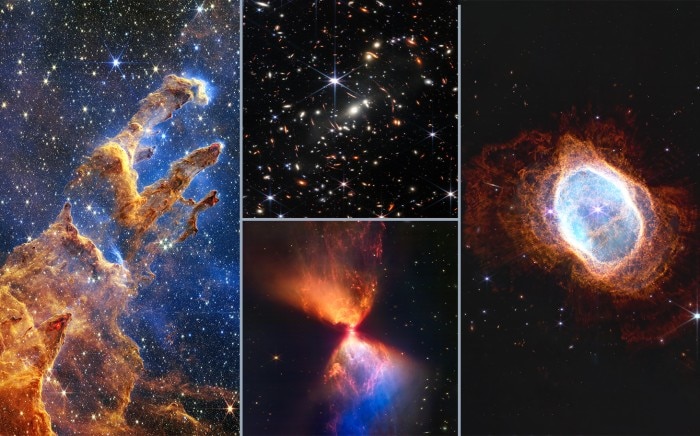
Awe-Inspiring Astronomy
Explore Life Science
- Off the Bench
- Inspiring Science
The James Webb Space Telescope has been delivering high-resolution images from space since 2022. These provide researchers with unforeseen findings about distant galaxies, displaying our cosmos in all its beauty. We present four spectacular images.
The Death of a Star
This image is among the first that the James Webb telescope – the largest space telescope built to date – sent to Earth in 2022. It shows the planetary nebula NGC 3132 (“Southern Ring Nebula”), approximately 2,500 light years from Earth, at a resolution that had hitherto been unattainable. The glowing cloud of burning gas and dust is what remains of a sun-like star at the end of its life. The originator of this cloud is not the large radiant star in the center, but the small one, visible to the left of the center, at the border between the bluish and the brownish areas. It is the telescope’s near-infrared camera (NIRCam) that allows us to see detailed images such as these. Since the sensors record wavelengths which are imperceptible to us, these were subsequently converted into visible colors. Thus, each one of these impressive images from space is also a work of art.

Revival of a Classic
The image of the “Pillars of Creation”, roughly 7,000 light years from us, already achieved fame in the 1990s. In 2014, the Hubble space telescope, with its much-improved technology, delivered more precise images. Since that time, the Eagle Nebula has been an iconic formation. Now, the James Webb telescope goes a step further by allowing the formation which also known as the “Hand of God” to shine in a new light once again. It shows novel details – for example, the glimmering red areas that are visible at the tips of some of the pillars. These are ejections from stars which, at a few hundred thousand years old, are still relatively young. According to the European Space Agency, new data such as these will allow better study of the conditions under which stars form within the Eagle Nebula, which stretches across roughly four light years.

Interstellar Vacuum
This colorful image – generated on September 8, 2022 – shows a very early phase in the development of a star. Its origin is an expansive cloud of gas and dust, at a distance of approximately 460 light years, inside which matter slowly contracts under the influence of gravity, compressing it to form the protostar L1527. This embryo of a star itself is located at the “waist” of the cosmic hourglass and will thus act as the center of attraction for additional matter. This will accumulate in an “accretion disc”, the narrow side of which is visible in this image as a fine dark line by the polar star. In this way, the baby star feeds itself, until it is so dense and hot that the fusion fire will ignite inside it – which marks the beginning of its life as a glowing star. In all probability, this is how our own sun may have come to life once upon a time.

Zooming into Space
Due to their gravity, galaxy clusters distort the light and can thus become what is known as gravitational lenses. These multiply and enlarge the images of galaxies in the background. This sparkling image shows the galaxy cluster SMACS J0723.3-7327. Before the James Webb telescope focused in on it, using its NIRCam to take high-resolution images, only 19 multiple images of six background sources had been known. Thanks to the JWT, 27 additional multiple images of ten further objects can now be identified. On the occasion of the publication of these images in the summer of 2022, astrophysicist Sherry Suyu of the Technical University of Munich said: “These spectacular images show a large variety of greatly enlarged galaxies which, thanks to our exact model, can now be studied in detail.”

